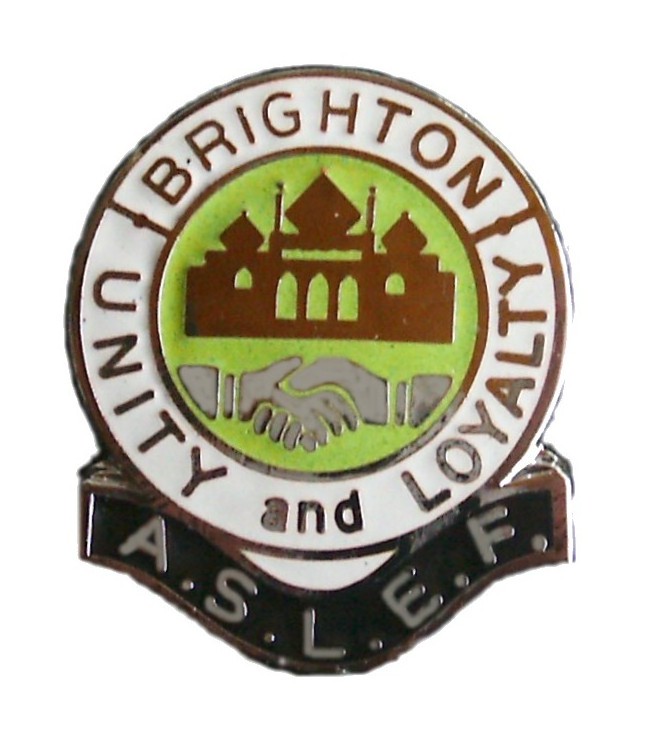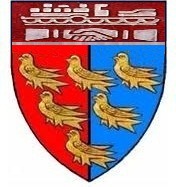Brighton Station Collision
Sunday 21st August, 1859
extracted and adapted from the Ministry of Transport Report
By H.W. Tyler.
The immediate approach to the arrival platform of the Brighton station is on an S curve, by which the view is much
obstructed. The passenger shed extends for 100 yards from the end of this platform. The available platform reaches 28 yards
beyond the shed. There is a semaphore signal, at which a switchman is 85 yards further northward. The ticket platform, which
is 150 yards long, is 100 yards from the semaphore signal. There is a disc signal on the end of the passenger shed, in a
conspicuous position.
All the passenger trains, with the exception of those which run express from London to Brighton, stop in the first instance at
the ticket platform. Whilst the tickets are collected, after the arrival of a train at this platform, the engine is detached from the
front, and taken round to the tail of the train. It is then coupled to the hind van, and, when all is ready, it pushes the train
before it into the passenger shed.
There is a stationary spring buffer at the end of the arrival platform; and in order that the driver may know when the front of
his train, as he pushes it before him, approaches this buffer, the disc signal which I have referred to, as being placed on the
end of the shed, is worked in a peculiar manner. There is a treadle fastened to the left hand rail 32 yards from the buffer, which
turns the signal on when the carriage passes over it; and the driver, in pushing his train into the shed, thus has the means of
ascertaining by the turning of the signal, as the leading carriage passes over the treadle, the moment when the front of his
train is within about 4 carriage lengths of the buffer.
On Sunday morning, the 21st August, as the last of three excursion trains from London, was being pushed into the passenger
shed from the ticket platform, it was forced against the stationary buffer with some little violence, to the injury, it is stated, of 5
of the passengers.
The train consisted of an engine and tender, 21 carriages, and 3 breaks. It left London at 9.25, and reached the ticket platform
at
leading van was against the stationary buffer, the engine stood near the semaphore signal.
There is no doubt that the driver pushed the train in from the ticket platform at a cautious speed; but he was evidently under a
misapprehension as to the length of his train, in relation to his distance from the end of the platform. When he ought to have
been bringing his train to a stand, he turned on his steam, in belief that he wanted more power to take the train in.
The switchman on duty at the semaphore signal, saw the steam issuing from the engine funnel, and knew at once what would
be the result. He says that he should not have thought the speed of the train too great under other circumstances, but that as
he perceived that there was a little steamed turned on he walked towards the driver, and warned him to “look out, as the train
was nearly home.”
The shock was by no means a severe one, and some of those who witnessed it, were not aware until afterwards that it had been
sufficient to cause personal injury; but it unfortunately happened at the moment when the passengers were standing up in their
carriages; in the leading portion of the train, and were preparing to alight on the platform; and thus it was that some injuries
were more severe than could otherwise have been anticipated.
The three guards state that they had their brakes on for some distance. The guarding in the leading van asserts that his wheels
were skidding all the way down the shed; but this would appear, from the evidence of the bystanders, not to have been the
case. They saw him screwing his break on, as the speed of the train increased, shortly before his van came into collision with
the stationary buffer.
The driver was an experienced man. He had driven for 18 months in the service of the Brighton Company, and for 8 years
previously in the Great Northern Company. But his regular duties were on the Crystal Palace Railway, and he had only taken
excursion trains to Brighton some 8 times before this occurrence. His fireman had done so much more frequently: and the
three guards were well accustomed to that service. But, strange to say, they were none them acquainted with the peculiar
object of the disc signal on the end of the shed until after the day in question.
This signal is more intended, no doubt, for the drivers than for guards; but it affords, also a useful indication to the guard who
rides in the last van of a long train; and they ought, clearly, all to be acquainted with it.
It has been the custom, of the station master to meet trains of this description at the entrance to the station, and himself to
indicate to the drivers, as a further precaution, at what point they should stop. Ignorance of these men, in regard to the
working of the disc signal is, perhaps partly owing to their depended upon the signals of the station master, and to their
having required no other guidance. The station master was absent from illness on the present occasion; and his assistant, who
was not far from the same spot, by holding his hands, was not seen from the engine.
The traffic manager of the Company, who appears to be much astonished at the ignorance which these men have discovered in
regard to the working of the disc signal, proposes to make immediate means for making it well known to all those of the
Company’s servants to whom it may be of use. The signal has been up for 3 or 4 years, and is no doubt, most valuable to the
drivers at Brighton.
The practice of backing a train into a station is always an objectionable one, and it becomes particularly so when that train is
180 yards long, and is pushed round a curve on which the view is obstructed, as in the present instance. The Brighton
Company have not sufficient platform accommodation in their passenger shed for these large trains; and their principal
reasons for working in this manner is to afford this accommodation to as many of the passengers as possible. If the engine ran
first into the shed, it would occupy the space of two carriages, and the passengers contained in those carriages would have to
alight upon the line, as 7 carriages full of passengers had to on the occasion in question. The company sought for powers
from Parliament, during the last session, to enable them to remedy these defects, and I believe they have it in contemplation to
make some improvements in the Brighton Station at an early date.
In the meantime, it would be almost better if they could make arrangements for collecting the tickets at some previous point,
and if they could allow the passengers of these very long trains to alight at the ticket platform, which is just long enough to
accommodate the longest train, though not nearly so wide as is desirable for such a purpose.


